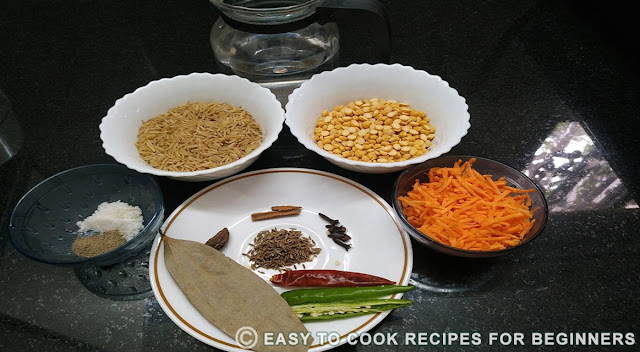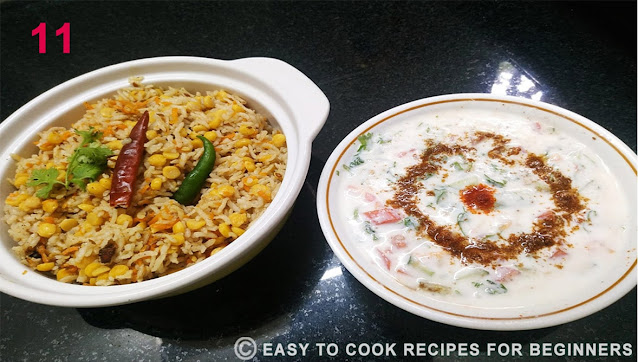Khichdi, is the humblest yet fulfilling and complete one pot meal is as ancient as Indian culture. It is derived from Sanskrit word 'khicca' which means a dish of rice and lentils. Lentils are must in Indian homes as they are rich in protein and vital vitamins and minerals. Including lentils in the form of Khichdi is the easiest way to add them to one's diet.
Chana Dal Khichdi
Chana dal khichdi is a healthy recipe which is very simple and uses minimal ingredients for preparation. Unlike other khichdi which are semi-liquid, chana dal khichdi is like a dal biryani and is usually taken with plain yogurt or raita. The taste of chana dal is quite dominant along with the spices. Use desi ghee or a neutral vegetable cooking oil. Indians use desi ghee in all lentil preparations as it enhances the taste of the dish. Prepared with a combination of chana dal and brown rice the benefits are doubled along with the taste.
Rice is staple food of India since ancient times. There are numerous varieties of rice that can be found in India such as basmati, brown, red and broken rice. One may use basmati rice or split rice to prepare this simple and comforting recipe. But I have prepared it with brown basmati rice that makes it even healthier. I have shared the benefits of major ingredients like brown rice and chana dal in coming sections.
What is Brown Rice?
Brown rice is a whole grain with only the outer hull removed while leaving the bran and germ layer intact. This keeps the nutritional content in it intact.
Benefits of Brown Rice
After reading the benefits of brown rice you too would like to prepare it more frequently. The benefits are as below: -
1: Natural antioxidant
Brown rice is fibrous and is very good for the heart. Brown rice has antioxidant properties which keeps toxic levels in our body under control.
2: Rich Source of vitamins and minerals
It has various vitamins and minerals like vitamins B1, B2, B3, B6, vitamin E and K, magnesium, iron, calcium, and phosphorus which acts as natural tonic.
3: Aids in Weight Loss
Brown is favorite among the weight watchers. As it is rich in fibers it keeps one fuller for a longer time, preventing unhealthy snacking.
4: Keeps Blood Sugar Level in Control
One can naturally control diseases like diabetes by adding low carbs to the diet. Brown rice is an excellent example of controlling blood sugar levels. Brown rice has low glycemic levels. Including low glycemic levels of food will make the digestion process slow preventing sudden spike of sugar levels in the body.
5: Good for Digestion
The fibrous nature keeps one’s bowel circulation smooth. It is also an excellent food to be consumed when constipated.
6: Helps to keep cholesterol in control
Brown rice contains very little cholesterol which makes it a preferred food for people who have high cholesterol. It helps to bring down the levels of bad cholesterol (LDL) with the help of fibers present in it which binds with the cholesterol.
7: Stronger Bones
Rich in calcium and magnesium, it aids in the development of strong bones. A sufficient intake of calcium prevents diseases like arthritis.
Difference between Brown Rice and White rice
White is used on a large scale as compared to brown rice. But brown rice has more benefits than white rice. Brown rice is a whole grain thus contains more nutrients in the form of bran, germ and endosperm. All these aren’t found in white rice. White rice is minus the hull as well as bran layer and germ. Brown rice cooks slower compared to white rice.
After reading all the benefits and comparing it’s now your turn to decide which rice you would prefer.
Benefits of Chana Dal
Chana dal is vastly used all across India. It is rich in B complex vitamins like B1, B2, B3 and B9 which reduces the risk of creation of blood clots. It boosts metabolism. It is an excellent source of protein for vegetarians, protein plays an important role in cell development, building stronger bones. Chana dal has antioxidant properties which reduces inflammation. Magnesium in chana dal helps to relax the blood vessels, helping in normal function of the heart. It has high fiber content which gives the feeling of fullness for longer duration. Minerals like phosphorus aid in the development of healthier teeth and strong muscles.
Ingredients (serve -2 pax)
1/2 cup brown unpolished rice
1/2 cup chana dal
1/4 cup grated carrots (optional)
1tsp salt
1/2tsp black pepper
2 cups water
For tadka/tempering
1tsp ghee/clarified butter/oil
1 bay leaf
4 cloves
1 stick cinnamon
1tsp jeera/cumin seeds
1black cardamom
2 pinches Hing /asafetida
1 green chili slit
Photos and Video Steps for Khichdi
Wash the dal and rice a few times and soak in the measured 2 cups water.
Leave for 4 hours. Ideally you should soak the rice and dal four hours
before you are going to cook.
After 4 hours the rice and lentils
are swollen and soft and ready to cook.
Heat ghee in a pressure
cooker.
Add all the tempering ingredients.
Stir for 30 seconds.
Add the rice and dal with the same water in which it has been
soaked.
Add the carrots and seasoning.
Mix well and close the lid.
After the first whistle, lower the flame to a minimum and cook for 5 minutes. Turn off the gas and let the cooker cool on its own till the pressure is released. Open the lid and very gently mix the khichdi
Our khichdi is ready to be served with tomato cucumber raita.
Video
Method for khichdi preparation
Wash the dal and rice a few times and soak in the measured 2 cups water. Leave for 4 hours. Ideally you should soak the rice and dal four hours before you are going to cook.
After 4 hours the rice and lentils are swollen and soft and ready to cook.
Heat ghee in a pressure cooker and add all the tempering ingredients.
Stir for 30 seconds.
Add the rice and dal with the same water in which it has been soaked.
Add the carrots and seasoning.
Mix well and close the lid.
After the first whistle, lower the flame to minimum and cook for 5 minutes.
Turn off the gas and let the cooker cool on its own till the pressure is released.
Open the lid and very gently mix the khichdi.
Our khichdi is ready to be served.
Ingredients for raita (serve -2 pax)
Khichdi is usually accompanied by curd or some preparation of curd. So here is a quick recipe for tomato cucumber raita.
1 cup beaten curd
1/4 th cup finely chopped tomatoes
1/4 th cup finely chopped cucumber
2 tbsp finely chopped coriander leaves
1/4 th tsp salt or to taste
1/4 th tsp red chilli powder or to taste
1 tbsp cumin, carom and coriander seeds homemade masala (please refer to this preparation given in my recipe for chaat.
Method and Steps for Raita
Put all ingredients into the curd, mix well and serve.
Conclusion
Kichdi is derived from Sanskrit word 'khicca' which means a dish of rice and lentils. It is the staple Indian food.
Chana dal kichdi is a healthy recipe which is very simple and uses minimal ingredients. It is usually served with yogurt or raita. Chana dal is rich in B complex vitamins like B1, B2, B3 and B9
Brown rice is fibrous and good for the heart. It has more nutrients. Brown rice is a whole grain with only the outer hull removed while leaving the bran and germ layer intact
It contains vitamins and minerals like vitamins B1, B2, B3, B6, vitamin E and K, magnesium, iron, calcium, and phosphorus which acts as natural tonic.
You may use white rice if you don’t like brown rice.

















0 Comments
Leave your valuable feedback please